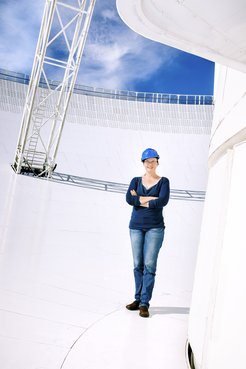“Radio bursts are a new tool”
The team of Laura Spitler wants to use the fast radio bursts as probes in the universe
Laura Spitler has been head of the Lise Meitner group “Universal detection of ionised matter with fast radio bursts” for almost a year. The team is working on one of the hot topics in astrophysics. At Cornell University in the US, Spitler wrote her doctoral thesis on these largely unexplained phenomena. Her group at the Max Planck Institute for Radio Astronomy in Bonn is currently investigating the space between galaxies with the help of fast radio bursts and using these bursts as probes for the intergalactic and interstellar medium. In an interview, the researcher explains her work.

Dr Spitler, how did you come to study radio bursts?
The discovery of the first burst was published in the scientific journal Science in 2007. At that time, I had just finished the first year of my doctoral thesis on the subject of short phenomena in the radio sky. But a fast radio burst was something novel and exciting. I therefore took a narrower view of the topic and focused my work on this phenomenon.
You completed your doctorate in 2012. Has anything changed in the field of radio bursts since then?
Yes, quite a lot. Especially in the last 18 months. Let me illustrate this with two examples of observation techniques. On the one hand, new radio telescopes have recently become available. Using these, the position of a burst in the sky can be directly and precisely determined. On the other hand, we have a telescope called CHIME in Canada. This has quite a wide field of view (i.e. it can see a fairly large section of the firmament). In test operations alone, this CHIME radio antenna has already registered 13 new bursts.
You are heading a Lise Meitner Group. What is their research objective?
We hope to gain a better understanding of how we can use the fast radio bursts to study the space between stars and galaxies. After all, the universe is not empty but rather filled with a more or less dense ionized gas, or “plasma”. Radio radiation from a distant burst must penetrate this medium and hit the particles in the plasma such as electrons and protons. In the process, fingerprints are imprinted on the radiation, so to speak. These signatures allow us to study the material – both intergalactic and interstellar – along the line of sight.
What are the benefits of such analyses?
This will enable us to study cosmological (i.e. large-scale) structures of the universe. And we can investigate those areas that seem empty at first glance – because there is plasma there too. Among other things, this is how we get to the bottom of the distribution of invisible dark matter. In this sense, radio bursts are not only fascinating and one of the greatest mysteries of astrophysics but also a new tool for performing measurements in different cosmic environments.
Interview: Helmut Hornung












